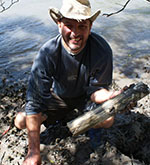- Baseline assessment of hydro-meteorological boundary conditions
- Scenario modelling and hazard assessment
- Socio-economic impact assessment, coping mechanisms and resilience
- Coastal vulnerability assessment
- Good governance, resilience and sustainable coastal communities
- Impact through public engagement, dissemination and dialogue between policy-makers and coastal communities
Work package 1: Baseline assessment of hydro-meteorological boundary conditions

Lead: Dr Raymond Ward, University of Brighton, UK.
Aim: to characterise the, recent past (~ 150 – 20 years) and present, coastal geomorphology, coastal protection & flood conditions, together with sedimentary processes including mass movements in river catchments, flood responses and deposition/erosion at the coast. During extreme hydro-meteorological events there are, potentially, two consecutive phases of geomorphic process: first, immediate, severe erosion and flooding on the coast via sediment removal and shoreline retreat; second, subsequent sediment provision to the coast through sediment pulses delivered from the catchment by rivers (e.g. via mass movements/landslides and/overland flow erosion caused by the increased rainfall). These operate within the constraints of historic and current coastal protection including distribution of natural ecosystems, such as mangroves, that protect the shoreline. Establishing and understanding the hydro-meteorological boundary conditions will facilitate scenario modelling under future predicted climate change scenarios.
Back to topWork package 2: Scenario modelling and hazard assessment

Aim: to model, under future climate change scenarios, meteorological, erosion, and flood occurrence in Nakhon Si Thammat and Krabi provinces. This will relate the modelled changes in sea level, storminess and precipitation to identify sedimentary responses along the coastline, and losses and gains related to changes in inputs and wave activity. This will also evaluate impacts of flooding (frequency and extent of inundation) related to storm surges and, in the case of estuarine environments, precipitation. These assessments of the magnitude and intensity of the coastal erosion and flooding will be used to create Hazards Index (HI) maps.
Output: maps of coastal erosion and flooding hazards predicted under future climate change scenario models.
Back to topWork package 3: Socio-economic impact assessment, coping mechanisms and resilience

Lead: Dr Uma Langkulsen, Thammasat University, Thailand.
Aim: to conduct a quantitative socioeconomic assessment of how people manage and respond to hydro-meteorological hazards.
Output: Socio-Economic Resilience Index Maps; report on coping mechanisms.
Back to topWork package 4: Coastal vulnerability assessment

Lead: Dr Pannee Cheewinsiriwat, Chulalongkorn University, Thailand.
Aim: to create a coastal vulnerability index, combining natural/physical, social and economic parameters (outputs of WP1, 2 and 3) to map the extent and level of coastal vulnerability to hydro-meteorological hazards under current and future climate change scenarios.
Output: Coastal Vulnerability Index Maps. Factors from the three dimensions will be weighted and combined, together with the hazards index maps and the socio-economic vulnerability index maps to generate a coastal vulnerability index map.
Back to topWork package 5: Good governance, resilience and sustainable coastal communities


Aim: to establish ‘good governance’ principles and ‘best practices’ for building resilient and sustainable communities, through comparative qualitative case studies of how institutional policy actors and coastal communities respond and adapt to hydro-meteorological hazard events.
Output: Policy, Implementation and Adaption Strategies Report – including literature and policy reviews, in-depth interviews (local communities, local agencies, and national agencies), governance arrangements, identifying ‘good governance’ and ‘best practices’ options for effective policy intervention, assessing barriers to uptake.
Work package 6: Impact through public engagement, dissemination and dialogue between policy-makers and coastal communities


Aim: to enhance public dialogue between stakeholders over risks from hydro-meteorological hazards, viable adaptation strategies, and pathways to resilient coastal communities. This is particularly important in the context of supporting and strengthening governance and institutional arrangements to mitigate the impact of hydro-meteorological hazards and enhance community resilience and sustainability. Establishing an improved institutional framework could involve a range of initiatives for co-management by governments and local communities that would allow, for example, the participation of the communities in decisions concerning the long-term management, development and utilization of resources.
Output: Building Community Awareness Workshop and public dissemination materials.
Back to top